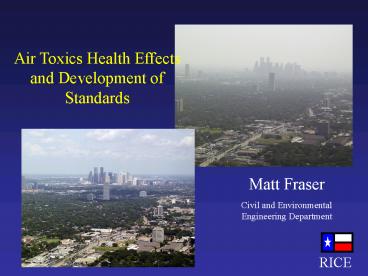Air Toxics Health Effects and Development of Standards - PowerPoint PPT Presentation
1 / 18
Title:
Air Toxics Health Effects and Development of Standards
Description:
(Air Toxics Apportionment Work at Rice University) RICE. Current Air Toxics Regulations ... Rice, Baylor College of Medicine, UT School of Public Health, UTMB ... – PowerPoint PPT presentation
Number of Views:19
Avg rating:3.0/5.0
Title: Air Toxics Health Effects and Development of Standards
1
Air Toxics Health Effects and Development of
Standards
Matt Fraser Civil and Environmental Engineering
Department
2
Overview
- Review of Ambient Measurements of Air Toxics
- Current Air Toxics Regulations
- Research Agenda for HEI Funded Project
- (Air Toxics Apportionment Work at Rice
University)
3
Current Air Toxics Regulations
- Emission standards NESHAPs (Title V CAAA 1990)
- regulate pollution control equipment for
specific - industries and sources of hazardous air
pollutants - Does not preclude state regulations of ambient
- concentrations of air toxics
- Texas has established Effects Screening Levels
(ESLs) - that are evaluated in permitting process
- usually set at 1 of threshold limit values
4
Other State Approaches
- California
- 10-6 carcinogenicity risk plus reference exposure
level established - by the California Office of Environmental Health
Hazard Assessment - Connecticut
- Hazardous limiting values established as ambient
air concentrations - by Commissioner of Health Services
- Louisiana
- Carcinogenicity risk not to exceed 10-4 for
regulated HAPS - Massachusetts
- 115 health based allowable ambient levels
5
Other State Approaches
- Michigan
- Initial Threshold Screening Level set by State.
Then carcinogenicity not to exceed 10-6. - New Jersey
- Carcinogenicity risk not to exceed 10-6 for
regulated HAPS - North Carolina
- State has set acceptable ambient pollutant
levels. If exceed these levels outside facility
property, must show maximum feasible control. - Rhode Island
- Ambient concentrations not to exceed benchmarks
set by State based on RfC from EPAs IRIS, CARBs
REL and New York acceptable levels
6
HEI Funding
- One year funding for six academic institutions
- Rice, Baylor College of Medicine, UT School of
Public Health, UTMB Galveston, Univ. Houston,
Texas Southern Univ. - Five Tasks
- -Identify and collect air toxics standards from
other states and other governmental agencies - -Determine health effect basis for existing
standards in other jurisdictions - -Review toxicological endpoint information and
epidemiological studies of health effects of
air toxics - -Compile local data on air toxics sources and
ambient levels - -Provide guidance on the chemicals that are of
concern, their health impacts, and how
standards could be implemented
7
Positive Matrix Factorization of Auto-GC Data for
Source Attribution
- Use statistical correlations in time series to
determine sources of VOCs - Studied three sites Wallisville Rd, HRM-3 and
Lynchberg Ferry
8
Representative Source Profiles
9
Representative Source Profiles
10
Lynchberg Source Attribution
- Refinery 115 ppbC
- Petrochemical Production 83 ppbC
- Gasoline Evaporation 71 ppbc
- Natural Gas 68 ppbC
- Aromatics 63 ppbC
- Other Industrial 13 ppbC
11
Temporal Variability in Source Strength
12
Combining Source and with Met DataConditional
Probability Function
13
Comparison to Inventory TCEQ Speciated Point
Source Data
14
Petrochemical Conditional Probability Function
15
Petrochemical Point Source Emission Inventory Data
16
(No Transcript)
17
2003 Benzene Data Annual Concentration vs. Wind
Direction
18
2003 Benzene Data at HRM-3 Comparison of Ambient
Data versus Inventory
Ambient Data
Inventory Data































